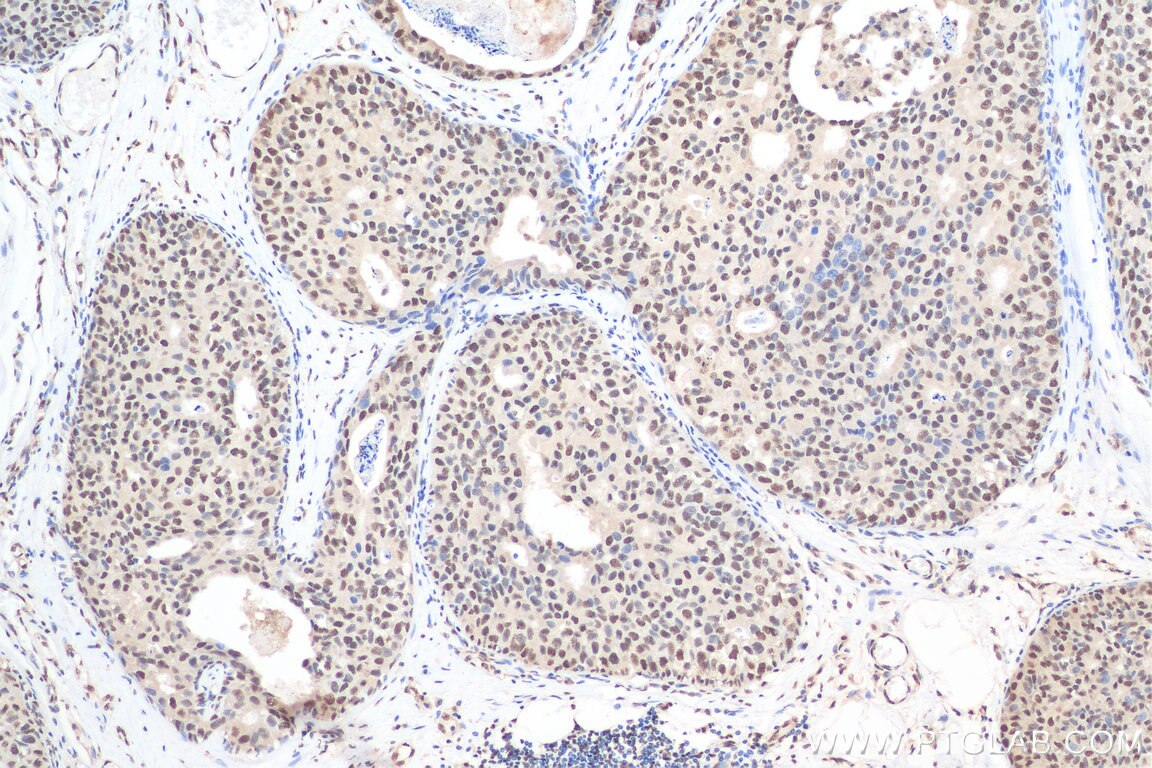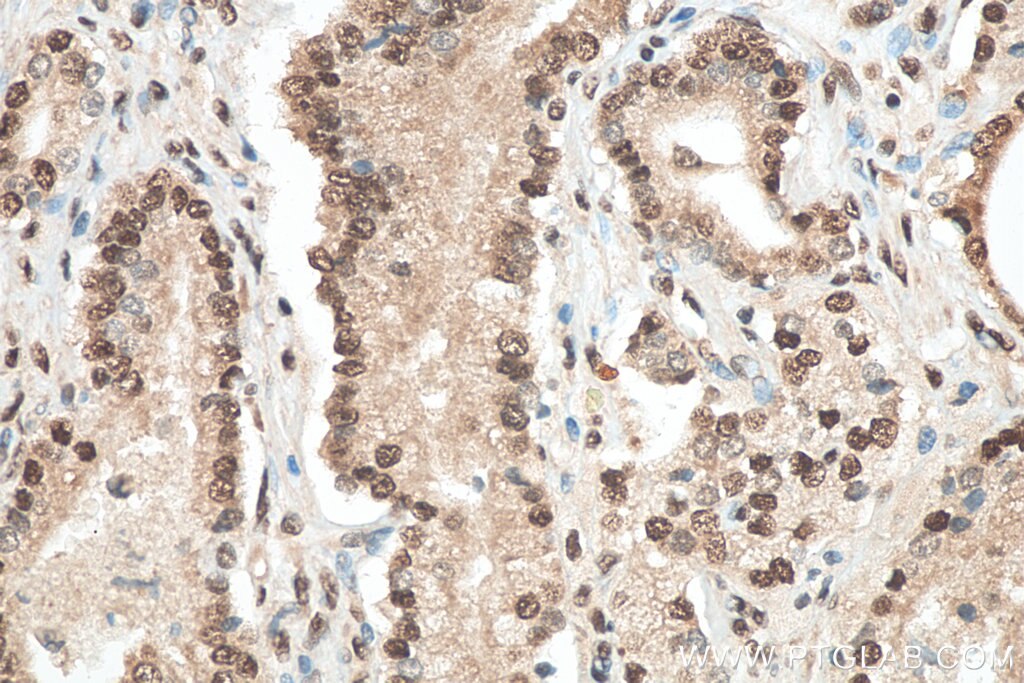- Phare
- Validé par KD/KO
Anticorps Polyclonal de lapin anti-C14orf166
C14orf166 Polyclonal Antibody for WB, IP, IF, IHC, ELISA
Hôte / Isotype
Lapin / IgG
Réactivité testée
Humain, rat, souris
Applications
WB, IHC, IF/ICC, IP, ELISA
Conjugaison
Non conjugué
N° de cat : 19848-1-AP
Synonymes
Galerie de données de validation
Applications testées
| Résultats positifs en WB | cellules A549, cellules Jurkat, tissu pancréatique de souris, tissu pulmonaire de souris |
| Résultats positifs en IP | cellules Jurkat |
| Résultats positifs en IHC | tissu de cancer du sein humain, tissu de cancer de la prostate humain il est suggéré de démasquer l'antigène avec un tampon de TE buffer pH 9.0; (*) À défaut, 'le démasquage de l'antigène peut être 'effectué avec un tampon citrate pH 6,0. |
| Résultats positifs en IF/ICC | cellules Jurkat, |
Dilution recommandée
| Application | Dilution |
|---|---|
| Western Blot (WB) | WB : 1:1000-1:6000 |
| Immunoprécipitation (IP) | IP : 0.5-4.0 ug for 1.0-3.0 mg of total protein lysate |
| Immunohistochimie (IHC) | IHC : 1:50-1:500 |
| Immunofluorescence (IF)/ICC | IF/ICC : 1:50-1:500 |
| It is recommended that this reagent should be titrated in each testing system to obtain optimal results. | |
| Sample-dependent, check data in validation data gallery | |
Applications publiées
| KD/KO | See 2 publications below |
| WB | See 7 publications below |
| IHC | See 4 publications below |
| IF | See 1 publications below |
Informations sur le produit
19848-1-AP cible C14orf166 dans les applications de WB, IHC, IF/ICC, IP, ELISA et montre une réactivité avec des échantillons Humain, rat, souris
| Réactivité | Humain, rat, souris |
| Réactivité citée | rat, Humain, souris |
| Hôte / Isotype | Lapin / IgG |
| Clonalité | Polyclonal |
| Type | Anticorps |
| Immunogène | C14orf166 Protéine recombinante Ag13900 |
| Nom complet | chromosome 14 open reading frame 166 |
| Masse moléculaire calculée | 244 aa, 28 kDa |
| Poids moléculaire observé | 28 kDa |
| Numéro d’acquisition GenBank | BC001722 |
| Symbole du gène | C14orf166 |
| Identification du gène (NCBI) | 51637 |
| Conjugaison | Non conjugué |
| Forme | Liquide |
| Méthode de purification | Purification par affinité contre l'antigène |
| Tampon de stockage | PBS avec azoture de sodium à 0,02 % et glycérol à 50 % pH 7,3 |
| Conditions de stockage | Stocker à -20°C. Stable pendant un an après l'expédition. L'aliquotage n'est pas nécessaire pour le stockage à -20oC Les 20ul contiennent 0,1% de BSA. |
Informations générales
Human CLE/C14orf166 protein is a positive modulator of cellular RNA polymerase. CLE is also shown to interact with the influenza virus polymerase complex and colocalizes with viral ribonucleoproteins, and is required for viral replication. Similarly, CLE is identified as a novel host interacting partners of the mature hepatitis C virus core protein. CLE levels were significantly higher in the serum of patients with PaCa compared with the control group was strongly expressed in tumor cells, suggesting that C14orf166 may be a potential biomarker of pancreatic adenocarcinoma.
Protocole
| Product Specific Protocols | |
|---|---|
| WB protocol for C14orf166 antibody 19848-1-AP | Download protocol |
| IHC protocol for C14orf166 antibody 19848-1-AP | Download protocol |
| IF protocol for C14orf166 antibody 19848-1-AP | Download protocol |
| IP protocol for C14orf166 antibody 19848-1-AP | Download protocol |
| Standard Protocols | |
|---|---|
| Click here to view our Standard Protocols |
Publications
| Species | Application | Title |
|---|---|---|
Nucleic Acids Res A novel all-in-one conditional knockout system uncovered an essential role of DDX1 in ribosomal RNA processing. | ||
Biosci Rep Overexpressed C14orf166 associates with disease progression and poor prognosis in non-small cell lung cancer. | ||
J Transl Med C14orf166 overexpression correlates with tumor progression and poor prognosis of breast cancer.
| ||
Tumour Biol C14ORF166 overexpression is associated with pelvic lymph node metastasis and poor prognosis in uterine cervical cancer. | ||
Tumour Biol Overexpression of chromosome 14 open reading frame 166 correlates with disease progression and poorer prognosis in human NPC. | ||
Mol Med Rep Expression and clinical significance of C14orf166 in esophageal squamous cell carcinoma. |











